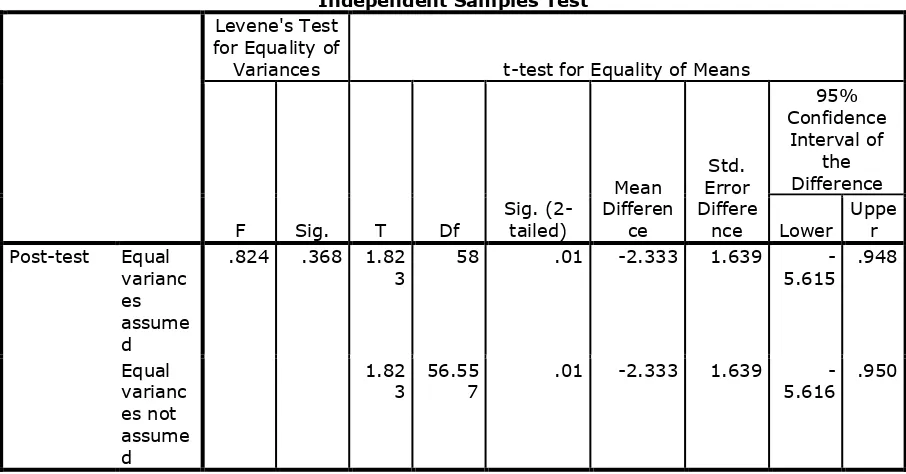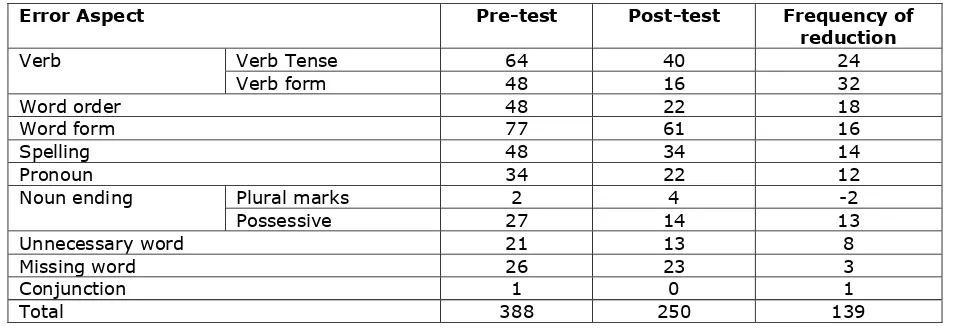Social Science
358
The Effect of Indirect Corrective Feedback in Reducing Error on
Students’ Writing
1*Endah Anisa Rahma, 2Siti Sarah Fitriani
1University of Teuku Umar, Meulaboh 23681, Indonesia;
2Department of English Education, University of Syiah Kuala, Banda Aceh 23111, Indonesia;
*Corresponding Author: [email protected]
Abstract
This experimental study aims to investigate the application of Indirect Corrective Feedback in reducing errors on students’ writing recount text. The subjects of the study were 60 tenth grade students of SMAN 1 Meulaboh chosen by random sampling. True experimental research was employed involving experimental group which was given Indirect Corrective Feedback and control group which was not given feedback. The instrument used was writing tests and the data were analysed by using Statistical Package for the Social Science (SPSS). This study focuses on giving Indirect Corrective Feedback on students’ writing recount in terms of grammatical features of the text. Therefore, there are nine error aspects mainly analysed, those are: verb, noun ending, spelling, word form, word order, pronoun, conjunction, missing and unnecessary word. The findings indicate that Indirect Corrective Feedback helps students to reduce errors in nine aspects. It is shown from the decrease of mean number of error in the post-test ( ̅= 12.17) which was lower than in the pre-test ( ̅= 27.07 ). It was also proven from errors performed in the pre-test as much as 388 and in the post-test as much as 250 from nine error categories. The results revealed that there was the reduction of error in the post-test. The finding confirmed that there is a significant difference between the results of post-test from both groups. It means that Indirect Corrective Feedback significantly improved the students’ writing achievement by the reduction of errors.
Key words: Indirect Corrective Feedback, error, writing.
Introduction
English is taught in Indonesian formal education as foreign language. Therefore, some difficulties are common in learning English. One aspect of teaching and learning process is writing. Hence, writing is the skill needs to be learnt by the students. In the context of the teaching English in senior high school in Indonesia, particularly for first grade students, the students are expected to be able to write a simple recount text based on its context and understand the social function, text structures and grammatical features of the text. Teaching writing for senior high school aims to develop the students’ competence in writing various types of texts from functional text to different text genres (Syllabus Diknas, 2013).
The difficulty in writing can come up from lack of understanding about grammar. Besides, the students were not interested in learning writing because they made the same error. From the writing task collection, it was shown that teacher did not give error correction to the students’ writing task. Teachers just put cross mark on the error part without providing the correct form. Most of them give composition assignment without any marks of correction to the students’ work and no discussion of error in the classroom before or after giving the work back to the students (Hartono, 2010). In this situation, this present study assumes that teachers need to apply new technique that can utilize students’ mistake by using correction code on students’ writing so that they can improve their writing easily, which is called as corrective feedback.
Social Science
359
students the opportunity to look up their errors (Corpuz, 2011). Therefore, this study investigated to the use indirect corrective feedback in students’ recount text to reduce errors on their writing. The research question posed by this study is “Is there any significant difference between the students who are given Indirect Corrective Feedback and those who are not given Indirect Corrective Feedback in terms of grammatical errors?”
Literature Review
Writing
According to Nunan (2003, p. 88), writing is the process of thinking to invent ideas, thinking about how to express into good writing, arranging ideas into statement and paragraph clearly. It means that when learners want to writes a composition well; they have to organize idea as well. In the context of the teaching English in senior high school in Indonesia, particularly for first grade students, they are expected to be able to compose descriptive, recount and narrative text. The focus of this present study is recount text. According to Derewianka (1990, p. 14), recount is the unfolding of a sequence of events over time.
Error
Dulay, Burt, and Krashen (1982, p. 70) define errors as the flawed side of learners’ speech or writing, which deviates from some selected norm of mature language performance. In other words, error occurs because the learners do not know what is correct, and thus it cannot be self-corrected. Grammatical error categories have been identified by Ferris and Robert (2001) into five categories, they are considered verb errors, noun ending errors, article errors, wrong word and sentence structure errors. In this study, the aspect of errors focus on grammatical feature of recount text which was adapted from Ferris and Robert (2001), Dewerianka (1990) and Butt, Fahey, Feez, Spinks and Yallop (2003). Therefore, there are nine aspect of errors mainly focus; verb, noun ending, spelling, word from, word order, pronoun, conjunction, missing and unnecessary word.
Feedback
In addressing grammatical errors on students’ writing, teacher can use two types of strategies, Direct Corrective Feedback (DCF) and Indirect Corrective Feedback (ICF) (Ferris & Hegdcock, 2005; Hendrickson, 1984; Lalande, 1982).
Direct Corrective Feedback (DCF) is done by providing the correct form (Ellis, 2009, p. 99). In other words, DCF is the provision of correct answer in response to students’ error (Lee, 2008, p. 67). Indirect Corrective Feedback refers to the situations when the teacher marks the errors have been made but the teacher does not supply the correct form so that the learners diagnose and correct the error (Lee, 2004). Coded ICF refers to locate the errors and the types of errors that are marked. In this study, the researcher used coded ICF.
Research Method
Research Design
This is experimental research which consists of two classes, chosen as the sample by using random sampling technique. One class was chosen as experimental group which was given IDF on writing recount, whereas another class was chosen as control group which was not given error correction.
Participants
The participants of the present study contained 60 X/MIA students of SMAN 1 Meulaboh. They were randomly assigned into two groups (one experimental and one control group). Each group consists of 30 students.
Data Collection Technique
Social Science
360
Next meeting, the writing task with second feedback was returned and the students did second revision. Post-test was conducted the last meeting. Students were given the topic about “unforgettable experience”.
Result and Discussion
The result from the statistical data analysis is presented in Table 1 as follows:
Table 1. Statistic result summary from pre-test of Control and Experimental Group Independent Samples Test
Levene's Test for Equality of
Variances t-test for Equality of Means
F Sig. T Df
The result from Table 1 shows that t-counted from the pre-test of both groups is -1.18. T-table for df = 58 at the level significance 5% (α = 0.05) is 1.68. The result shows that tcounted ޒ ttable (-1.188 ޒ 1.68). Therefore, H0 is accepted and Ha is rejected. This has indicated that there is no significant difference in the pre-test results between the two groups. Meanwhile, Table 2 shows that the statistical result of post-test from both groups.
Table 2. Statistic result summary from post-test of Control and Experimental Group Independent Samples Test
Levene's Test for Equality of
Variances t-test for Equality of Means
F Sig. T Df
Social Science
361
students’ writing recount text in the experimental group in terms of error reduction after the treatment is given. This following table shows that the description of error aspect in pre- and post-test.
Table 3. Total error aspect and reduction from the Experimental Group
Error Aspect Pre-test Post-test Frequency of reduction
Verb Verb Tense 64 40 24
Verb form 48 16 32
Word order 48 22 18
Word form 77 61 16
Spelling 48 34 14
Pronoun 34 22 12
Noun ending Plural marks 2 4 -2
Possessive 27 14 13
Unnecessary word 21 13 8
Missing word 26 23 3
Conjunction 1 0 1
Total 388 250 139
The table above shows list of total error aspects from pre-test and post-test in experimental group. The table shows that verb is the dominant error and the most reduced error. Meanwhile, conjunction is the lowest error. The following is total error and reduction from control group.
Table 4. Total error aspect and reduction from the Control Group
Error Aspect Pre-test Post-test Frequency of Reduction
Verb Verb Tense 80 42 38
Verb form 43 38 5
Word order 55 21 34
Noun ending Plural Mark 8 7 1
Possessive 35 2 27
Pronoun 37 8 28
Spelling 46 32 14
Unnecessary word 19 6 13
Missing word 31 22 9
Word from 66 74 -8
Conjunction 0 0 0
Total 417 255 204
The table above show list of total error aspects from pre-test and post-test in control group. The table also shows that verb is the dominant error and the most reduced error. Word form is aspect that does not have improvement since there is the higher error found on post-test.
Conclusion and Recommendation
Social Science
362
References
Butt, D., Fahey, R., Feez, S., Spinks, S., & Yallop, C. (2003). Using functional grammar: An explorer’s
guide. 2nd Ed. Sidney: National Centre for English Teaching and Research.
Corpuz, V. F. (2011). Error correction in second language writing: Teachers’ beliefs, practices, and
students’ preferences. Unpublished Master’s thesis. Queensland, University of Technology.
Available at: http:/www.eprints.qut.edu.au/49160/1/Victor_Corpuz_Thesis.pdf/ Derewianka, B. (1990). Exploring how texts work. Sydney: Primary Teaching Association. Dulay, H., Burt, M., & Krashen, S. (1982). Language two. New York: Oxford University Press. Ellis, R. 2009. A typology of written corrective feedback types. ELT Journal,63: 97-107.
Ferris, D. R., Chaney, S. J., Komura, K., Robert, B. J., & McKee, S. (2000). Perspective, problem, and
practice in treating written error. Presented at the International TESOL Convention. March
14-18Vancouver, B. C.
Ferris, D., & Robert, B. (2001). Error feedback in L2 writing classes: How explicit does it need to be?
Journal of Second Language Writing, 10: 161-184.
Ferris, D. R. (2003). Response to writing: Implication for second language students. Mahwah, N. J.: Lawrence Erlbaum.
Ferris, D. R., & Hedgcock, J. S. (2005). Teaching ESL composition: Purpose, process, and practice. New Jersey: Lawrence Erlbaum Associates.
Hartono. (2010). The effectiveness of grammar correction to improve students’ writing. ELT Journal, 63(1): 91-102.
Hendricson, J. (1984). The treatment of written work.Modern Language Journal, 64: 216-221. Kementrian Pendidikan dan Kebudayaan. (2013). Buku guru SMA/MA/SMK/MAK. Jakarta: Kemdikbud. Lalande, J. F. (1982). Reducing composition error: An experiment. Modern Language Journal, 66(22):
142-149.
Lee, I. (2004). Error correction in L2 secondary writing classrooms: The case of Hong Kong. Journal of
Second Language Writing, 13(4): 285–312.
Lee, I. (2008). Understanding teachers’ written feedback practise in Hong Kong secondary classroom.
Journal of Second Language Writing, 17: 69-85
Nunan, D. (2003). Practical English language teaching. Singapore: McGraw Hill.

